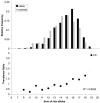A genome-wide association study implicates diacylglycerol kinase eta (DGKH) and several other genes in the etiology of bipolar disorder
- PMID: 17486107
- PMCID: PMC2527618
- DOI: 10.1038/sj.mp.4002012
A genome-wide association study implicates diacylglycerol kinase eta (DGKH) and several other genes in the etiology of bipolar disorder
Abstract
The genetic basis of bipolar disorder has long been thought to be complex, with the potential involvement of multiple genes, but methods to analyze populations with respect to this complexity have only recently become available. We have carried out a genome-wide association study of bipolar disorder by genotyping over 550,000 single-nucleotide polymorphisms (SNPs) in two independent case-control samples of European origin. The initial association screen was performed using pooled DNA, and selected SNPs were confirmed by individual genotyping. While DNA pooling reduces power to detect genetic associations, there is a substantial cost saving and gain in efficiency. A total of 88 SNPs, representing 80 different genes, met the prior criteria for replication in both samples. Effect sizes were modest: no single SNP of large effect was detected. Of 37 SNPs selected for individual genotyping, the strongest association signal was detected at a marker within the first intron of diacylglycerol kinase eta (DGKH; P=1.5 x 10(-8), experiment-wide P<0.01, OR=1.59). This gene encodes DGKH, a key protein in the lithium-sensitive phosphatidyl inositol pathway. This first genome-wide association study of bipolar disorder shows that several genes, each of modest effect, reproducibly influence disease risk. Bipolar disorder may be a polygenic disease.
Figures





References
-
- Risch N, Merikangas K. The future of genetic studies of complex human diseases. Science. 1996;273:1516–1516. - PubMed
-
- Detera-Wadleigh SD, McMahon FJ. Genetic association studies in mood disorders: issues and promise. Int Rev Psychiatry. 2004;16:301–301. - PubMed
-
- Jorgenson E, Witte JS. A gene-centric approach to genome-wide association studies. Nat Rev Genet. 2006;7:885–885. - PubMed
-
- Clark AG, Boerwinkle E, Hixson J, Sing CF. Determinants of the success of whole-genome association testing. Genome Res. 2005;15:1463–1463. - PubMed
-
- Sham P, Bader JS, Craig I, O'Donovan M, Owen M. DNA Pooling: a tool for large-scale association studies. Nat Rev Genet. 2002;3:862–862. - PubMed
Publication types
MeSH terms
Substances
Grants and funding
- MR/K01417X/1/MRC_/Medical Research Council/United Kingdom
- R01 MH059545/MH/NIMH NIH HHS/United States
- Z01 MH002810/ImNIH/Intramural NIH HHS/United States
- R01 CA098438/CA/NCI NIH HHS/United States
- R01 MH059586/MH/NIMH NIH HHS/United States
- Z01 MH002842/ImNIH/Intramural NIH HHS/United States
- R01 MH059566/MH/NIMH NIH HHS/United States
- R01 MH059588/MH/NIMH NIH HHS/United States
- R01 MH059553/MH/NIMH NIH HHS/United States
- R01 MH060879/MH/NIMH NIH HHS/United States
- R01 MH060068/MH/NIMH NIH HHS/United States
- R01 MH061675/MH/NIMH NIH HHS/United States
- R01 MH059556/MH/NIMH NIH HHS/United States
- Z01 MH002843/ImNIH/Intramural NIH HHS/United States
- R01 MH059535/MH/NIMH NIH HHS/United States
- R01 GM60457/GM/NIGMS NIH HHS/United States
- G0701075/MRC_/Medical Research Council/United Kingdom
- R01 MH059567/MH/NIMH NIH HHS/United States
- R01 MH059548/MH/NIMH NIH HHS/United States
- R01 MH067257/MH/NIMH NIH HHS/United States
- R01 MH060870/MH/NIMH NIH HHS/United States
- R01 MH059534/MH/NIMH NIH HHS/United States
- R01 MH059571/MH/NIMH NIH HHS/United States
- R01 MH059565/MH/NIMH NIH HHS/United States
- R01 MH059587/MH/NIMH NIH HHS/United States
- R01 MH059533/MH/NIMH NIH HHS/United States
LinkOut - more resources
Full Text Sources
Other Literature Sources
Medical
Molecular Biology Databases
Research Materials
Miscellaneous

